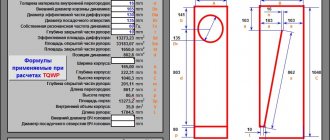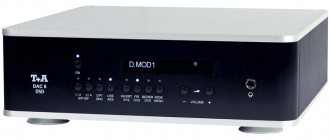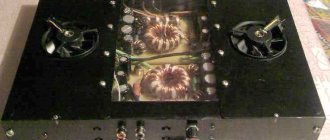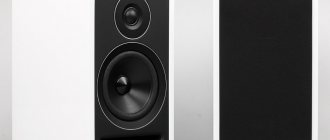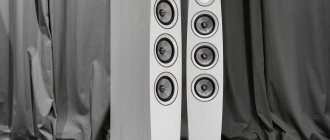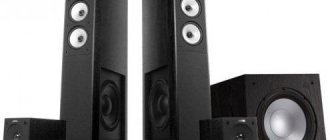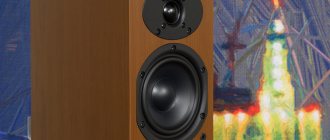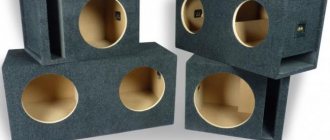The JBL brand has been using horn tweeters in professional speaker systems six decades ago. Today, such tweeters are an indispensable part of loud car audio systems, and it would be surprising if JBL ignored this fact. Let's get acquainted with the new product.
The design of horn tweeters has been brought to perfection during their existence, but the emergence of new materials and technologies has made it possible to push the boundaries of the usual characteristics. Optimization has significantly reduced the characteristic “horn” whistling sounds, expanded the radiation pattern, and reduced distortion.
To increase the sound pressure developed by the dynamic head, it is necessary to improve its coordination with the environment - air. The role of such an “acoustic transformer” is played by the horn, and for high-frequency emitters its size can be quite modest, as well as the size of the emitting surface itself. In the JBL Shock Wave 4T tweeter, the diameter of the radiating diaphragm is only 25 mm, and the diameter of the horn mouth is 62 mm. The 4T designation in the model name refers to the diaphragm material (titanium) and the rounded flange diameter in inches.
The extremely rigid and elastic titanium diaphragm is lightweight - this makes it possible to expand the range of reproduced frequencies to 20 kHz and obtain a highly accurate tweeter response to the applied signal with minimal distortion. The geometry of the load chamber, the horn profile and the design of the central phase-equalizing “bullet” provide a wide radiation pattern and good frequency response.
The elegant precision cast aluminum body not only provides high performance, but also allows for a stylish and aesthetically pleasing installation.
The dimensions of the horn tweeter are quite modest, which simplifies their placement and installation.
Includes high quality 2.2uF metal film capacitors
When connected in series with tweeters, capacitors act as high-pass filters, eliminating overload with low and mid frequencies. But not only this, as measurements have shown - capacitors also correct the shape of the frequency response, leveling the output across the range and expanding the radiation pattern. How? And now you will find out...
MEASUREMENTS
The electroacoustic parameters in the passport are presented succinctly:
- Impedance: 4 ohms
- Operating frequency range: 2500 - 20000 Hz
- Sensitivity: 103 dB/W/m
- Nominal/maximum power: 35/70 W
We will find out the rest during the measurement process, and we will start with the Z-characteristic.
Adjacent to the resonance of the moving system (2.2 kHz) is a small spike at 4.8 kHz - this is the acoustic resonance of the pre-horn chamber, and, as will be seen later, it will manifest itself in the frequency response
Thiel-Small parameters
| FS, Hz | 2219 |
| RE, Ohm | 4,2 |
| QTS | 2,78 |
| QMS | 6,57 |
| QES | 4,83 |
With a rigid titanium membrane, the mechanical quality factor is quite high, and the resonance is very pronounced. Let's see how this affects the frequency response and sound.
In the tweeter’s own frequency response (first graph), the mechanical resonance (2.2 kHz) and the dip from the pre-horn chamber (4.8 kHz) are clearly visible, and the axial frequency response drops off above 10 kHz. But everything changes dramatically when a capacitor is connected - it forms a first-order filter with a cutoff frequency of 17-18 kHz and perfectly corrects the frequency response (second graph). And the angular frequency response becomes horizontal (third graph)
Silk tweeter PUZU AUDIO PZ-B25 from Aliexpress
Hi all! China and the ALIEXPRESS platform never cease to amaze us with goods that are not typical for these places. I present to you NONAME from Ali, PUZU AUDIO tweeters. Not a great name? It looks like it shouldn’t be loud - this is a product for Ali, occupying its niche and that’s all.
The history of the purchase of these speakers. (To make it clear why you should buy tweeters from Ali) I was the happy owner of automobile silk tweeters from the Italian company PHD. Everything was great until they grunted due to my fault. The coils burned out from the clipped signal. The price tag for new ones is prohibitive and I started looking for repair kits on Ali. I found out that almost all silk dome tweeters have similar sizes of moving systems, and it looks something like this:
I was too lazy to press the BUY button, I was too lazy to take apart the broken ones, glue them, wait. And I didn't buy a repair kit. Then a miracle happened on Ali and I came across PUZU AUDIO PZ-B25 in an advertising window. Having assessed all the pros and cons in my head, I decided to order. The choice was either one pair from Italy of a famous brand (assembled in China) for 6000 rubles, or two pairs from China for 2600 (the price was lower, 1300 per pair). I have never believed that you can buy sane audio components on Ali at an affordable price, so that they are no worse in assembly than the same European brands. Now I believe. This is what I received. Don't look at the capacitors (it was the Russian who mocked them, not the Chinese).
And so the equipment: 1. Box 2. Tweeters 2 pcs. 3. Instructions 4. Capacitors 2 pcs. Characteristics: Type: Automotive silk tweeter, 25 mm dome type Impedance: 3.2 Ohm; Frequency response: 2500-20 kHz Sensitivity: 91 dB Rated power: 40 W Maximum power: 120 W
There are three colors. PZ-G25
puzu pz-s25
The build quality is excellent: 1. One-piece, milled, anodized aluminum body. 2. Quite durable and compact neodymium motor; there may be ferromagnetic fluid in the coil gap. 3. It looks like there is high-quality black glue inside the case, everything is filled smoothly and without jambs. 4. High-quality markings on the back, looks like a laser. 5. Lack of identification marks on the front of the speaker (I consider this a plus). 6. Tinned copper wire, high-quality threads and knurling.
A temporary installation option to assess what is happening.
Actually my opinion in the video
Let's summarize. Puzu audio PZ-B25 tweeters are a product of the highest quality both in terms of sound and build quality. Analogs of these speakers in our market cost from 4000 rubles. for a couple, approximately. It’s difficult for me to evaluate the sound character of these speakers; there’s nothing special to compare them with. But the character is very similar to speakers with ferrofluid in the gap. The sound is no worse than the same Italy, for this money. The speakers easily survive connections to amplifier channels with a power of 180 W per channel with second-order cutoffs from 2500 Hz, no heating was noticed. These speakers are suitable for those who want to pump up the sound from their radio and for those who like to pour more into the speaker from an amplifier, and even for modest home acoustics assemblies. I think this is an ideal option for assembling a cheap two or three-way system when there is no talk about horn-type speakers and loud systems. Thanks to all.
PERSONAL EXPERIENCE
This is not the first time my opinion about “mouthpieces” has been corrected. For the better. Much can be sacrificed for loudness, but not sound quality. It turned out impressive, the sound is quite smooth even in the simplest configuration (with the supplied capacitor). But for higher sound quality, it is useful to set the crossover in the amplifier or processor to 4-5 kHz - this will completely suppress the remnants of mechanical resonance. In this case, it is better to leave the capacitor - it corrects the frequency response, and without it you will have to “adjust” its processor - it is not a fact that it will get better.
The dispersion of the radiation is wide, the most informative range up to 10 kHz is played perfectly over almost the entire front, regardless of the position of the listener. A slight excess of the highest frequencies (8-20 kHz) on the axial frequency response for open air is only a “plus”, it will further achieve further.
Tweeters silk
Catalog
- Trade equipment Economy panels and accessories Economy panels
- Inserts for economy panels
- Economy stands for economy panels
- Hooks for economy panels
- Brackets for economy panels
- Baskets for economy panels
- Boxes for economy panels
- Holders for economy panels
- Shelves for economy panels
- Stoplocks clamps for hooks
- Trade crosspanel and accessories
- Metal wall racks
- Shelf price holders
- Wall plastic pockets
- Plastic frames, information pockets
- Hanging in loft style
- Joker 25 system
- Clothes hangers
- Etiquette guns
- Female mannequins
- Fitting rooms
- Trading grids (grids)
- Vertical/NeoFix system
- Booklets
- Stands for glasses
- Currency detectors
- Leather and flocked jewelry stands
- Sales baskets, storage bins
- Trade tents, marquees
- Hooks for perforated MDF panels
- Washing baths
- Trade equipment for pharmacies
- Accessories, interfaces, consumables, electrical tape Accessories, antennas, couplers, hex screws, electrical tape
- Coaxial, broadband
- Parking sensors, sensors, displays
- processors, crossovers
- Voltmeters, ammeters
- Podiums, shelves, rings, blanks
- Batteries, generators, regulators, mounts
- Keychains, mugs, flags, lighters
- 10″
- Keychain covers
- 2 channel
- Installation of additional equipment and various services
- Vibration isolation materials
- Thermal leather, vinyl, Alcantara
- Spacer rings for speakers, blanks, dies
- Lamps LED, XENON, HALOGEN
- Anti-gravel (armor films), vinyl
- Packages
- Antiseptics
- Furniture locks
- Fire extinguishers
- Power supplies and dimmers for LED strips and lamps
- Floor mirrors
About company
- About Us
- Catalog
- Production
- Store design
- Portfolio
- Contacts
- Requisites
Information
- Store addresses
- Blog
- News
- Shipping and payment
- Product return procedure
- Policy regarding the processing of personal data
Cooperation
- For partners
- For dealers
HONEY AND TAR
The design is solid, at the same time quite compact and not too heavy, the quality of workmanship is high - the logo, the groove of the flange. Aesthetics are not the least important thing in Open Air. There are no obvious disadvantages. And the rest are all pluses: high sensitivity, musical sound, relative compactness and affordable price. JBL Shock Wave 4T can be used both in loud everyday audio systems and in competitive installations - the only question is quantity.
Issue price: 2,460 rub. (per pair)
New addition to the Shock Wave series
Test of JBL Shock Wave 4T horn compression tweeters
Not long ago, HARMAN finally paid attention to car loud systems and announced the launch of the Shock Wave series under the JBL brand. This move seemed logical, because the company has been working in the field of stage audio equipment for several decades. The first to see the light were the JBL Shock Wave 100W65 midrange speakers, but in addition to them there were clearly not enough tweeters. Now they are available - just the other day the horn compression JBL Shock Wave 4T went on sale.
I first became acquainted with pre-production samples of these tweeters in August last year, and at that time they showed themselves to be worthy. At least, from the large number of “variety” prototypes that have ever passed through the laboratory, the future JBLs stood out with very decent characteristics for such high-frequency drivers.
Now that the JBL Shock Wave 4T has officially gone on sale, the tweeters are back in the lab. Only this time they are no longer prototypes, but normal production samples taken from the first delivery. For reference, the price at the time of the test was 2390 rubles per pair.
First study, design
The aluminum cases are cast to order from JBL, as evidenced by the embossed logo on the flange. True, the decor is not the main thing here; the horn profile (as a source at HARMAN said) was also made according to its own specifications. By the way, the output, the shape of the frequency response in the operating range and the directivity of the radiation largely depend on it.
The radiating membrane is another important element that is invisible to the eye, but affects the sound. I've come across tweeters where they were made almost from aluminum cans - you couldn't tell the difference from normal ones without looking at them, but they sounded appropriate. Everything is fair here, and the membrane is not even aluminum, but titanium.
The planting depth is not too large - 4.2 cm. If desired, it can fit into door arrays without any problems.
The mounting diameter of the tweeter is 7.2 cm, the outer diameter is 9.8 cm.
Under the sticker you can feel the axial screw that holds the entire structure together. I needed to return the tweeters intact, so I didn’t disassemble them. But in general, there is an opportunity to change the membrane (if something happens) - it is of a standard 1-inch caliber with terminals located in the form of “ears”.
The kit includes capacitors with a nominal value of 2.2 µF. More often, “pop” tweeters are equipped with capacitors of 3.3 or even 4.7 uF, but specifically for the Shock Wave 4T these were more suitable. I will analyze this point a little further, in measurements.
Characterization and analysis of tweeters
The impedance graph looks decent - the main resonances are between 2 and 3 kHz and another small one is around 5 kHz. Often this graph “ripples” greatly from local resonances of the membrane, horn and other elements. Everything here is predictable, so that's it for now. The first intermediate pin – the main operating range of the tweeter starts above 5 kHz.
The frequency response above 5 kHz also behaves decently. Moreover, if you look directly at the tweeter, then at the very, very top you even get a rise in output. It is, however, not so important, since a normal “stage” is designed to operate in the far field (i.e., at a distance of several meters), and high frequencies tend to attenuate strongly over a distance. With a slight turn, the frequency response remains flat in this range, it just changes the slope.
Simply put, a tweeter sounds best when pointed roughly in the direction of the listeners, but not necessarily directly at them. This is a normal situation when scoring an open space.
By the way, the phase response is quite smooth for a “variety” tweeter – there are practically no “harmful” resonances above 5 kHz. And everything below is beyond the scope of the tweeter’s operation.
There are two important issues with distortion. The first is the unexpectedly low level of distortion in the operating frequency range. At least for the stage. The second point is that the increase in distortion below 3-4 kHz begins sharply, so you need to be more careful with setting the high-pass filter.
So in channel systems
set the high-pass filter to at least 5-6 kHz with a slope of 12 dB/octave. This guarantees that the sound on the high frequencies will be clear, without the characteristic “iron” ringing. The description, by the way, recommends approximately the same, and as an optimal setting it recommends 8 kHz with a slope of the same 12 dB/octave. Looks logical.
If a regular, non-channel system
, and the tweeters will be connected in parallel to the midrange drivers, then in this case the capacitor from the kit will come in handy. The description states that the 2.2 µF rating is selected for optimal matching of these tweeters with the JBL Shock Wave 100W65 midrange drivers. Since they also visited the laboratory, I added their frequency response for comparison. Here's how the tweeters will work with them when driven via 2.2uF:
Look what happens. In theory, a 2.2 uF capacitor gives a high cutoff frequency; all sorts of Internet calculators usually count something around 18 kHz. Does this mean that tweeters will only operate above this frequency? Of course not, just look at the graph - acoustically the Shock Wave 4T takes over from the Shock Wave 100W65 somewhere in the region of 4-5 kHz.
Briefly to the point
The main difference between the JBL Shock Wave 4T and most “pop” tweeters is the ability to work cleanly, without the characteristic metallic ringing or outright “whistle” (of course, if the system is configured correctly). They climb well up in frequency, and the distortion in the operating range is low.
As promised in the description, in channel-by-channel systems the optimal junction with the midrange is obtained in the region of 6-8 kHz (12 dB/octave). There is no need to lower the section below; most midrange frequencies normally reach these frequencies (and some go higher).
In simple, non-channel systems, you don’t have to worry too much and connect the tweeters through the supplied capacitor in parallel with the midrange speakers. In such systems, it is logical to assemble all the acoustics in one series - the Shock Wave 4T tweeters and the Shock Wave 100W65 midrange speakers are guaranteed to be consistent with each other.
- There is no tinny ringing or “whistle” in the sound
- Low distortion in the operating frequency range
- Climbing high in frequency
- They do not tolerate incorrect high-pass filter settings (minimum 6 kHz, 12 dB/octave)
